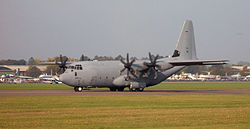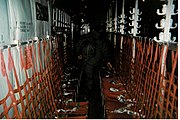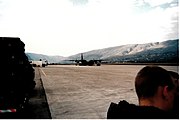C-130 Hercules
From Wikipedia, the free encyclopedia.
The Lockheed C-130 Hercules is a four-engine turboprop aircraft that serves as the main tactical airlifter for military forces worldwide. Capable of landing and taking off from short or unprepared runways, it was initially a troop transport and cargo aircraft that is now also used for a wide variety of other roles, including airborne assault, weather reconnaissance, aerial refuelling, aerial firefighting and medevac. There are more than 40 models of the Hercules, including several gunships, and it is widely used by more than 50 nations. Over more than 50 years of service, the C-130 family has established a solid record of reliability and durability, participating in military, civilian and humanitarian aid operations.
The C-130 family has the longest continuous production run of any military aircraft in history. The first YC-130 prototype flew on August 23, 1954 from the Lockheed plant in Burbank, California. The aircraft, serial number 53-3397, was piloted by Stanley Beltz and Roy Wimmer. After the two prototypes were completed, production moved to Marietta, GA, where more than 2,000 C-130s have been built.
Contents |
Development

The initial production model, the C-130A, was powered by Allison T56 turboprops with 3-blade propellers. Deliveries began in December of 1956, continuing until the introduction of the C-130B model in 1959. Some A models were redesignated C-130D after being equipped for skis and jet-assisted takeoff. The newer C-130B had ailerons with more boost — 3,000 vs 2,050 lbf/in² (21 vs 14 MPa) — as well as uprated engines and four-bladed propellers that were standard until the late 1990s. The performance gains over the C-130A gave the C-130B the reputation of being the design's 'sports car' model.
The extended range C-130E model entered service in 1962. The increased range was achieved by underwing fuel 1,360 U.S. gallon (5,150 L) tanks and more powerful Allison T-56-A-7A turboprops. The E model also featured structural improvements, avionics upgrades and a higher gross weight.
The KC-130 tankers, originally C-130Fs procured for the U.S. Marine Corps in 1958 (under the designation GV-1), are equipped with a removable 13,626 L (3600 US gallon) stainless steel fuel tank carried inside the cargo compartment. The two wing-mounted hose and drogue aerial refueling pods each transfer up to 19 L/s (300 US gal/min) to two aircraft simultaneously allowing for rapid cycle times of multiple-receiver aircraft formations (a typical tanker formation of four aircraft in less than 30 minutes). The U.S. Navy's C-130G has increased structural strength allowing higher gross weight operation.
The C-130H model has updated Allison T56-A-T5 turboprops, a redesigned outer wing, updated avionics, and other minor improvements. The H model remains in widespread use with the U.S. Air Force and many foreign air forces. Initial deliveries began in 1964, remaining in production until 1996. An improved C-130H was introduced in 1974. The equivalent model for export to the U.K. is the C-130K, known by the RAF as the Hercules C.1. The C-130H-30 (Hercules C.3 in RAF service) is a stretched version of the original Hercules, achieved by inserting a 2.54 m plug aft of the cockpit and a 2.03 m plug at the rear of the fuselage.
The C-130R and C-130T are U.S. Navy and Marine Corps models, both equipped with underwing external fuel tanks. The C-130T is similar, but has numerous avionics improvements over the R model and is fully night-vision system compatible. In both models, Marine Corps aircraft are equipped with Allison T-56-A-16 engines.
Civilian use
The Lockheed L-100 is a civilian variant, equivalent to a C-130E model without pylon tanks or military equipment. The L-100 also has 2 stretched versions: the L-100-20 has an 8.3 ft (2.5 m) fuselage stretch, and the L-100-30 is stretched by 15 feet (4.6 m).
Next generation
In the 1970s Lockheed constructed one C-130 with turbofan engines rather than turboprops, but the U.S. Air Force preferred the takeoff performance of the existing aircraft. In the 1980s the C-130 was intended to be replaced by the Advanced Medium STOL Transport project. However, the project was cancelled and the C-130 has remained in production.
The C-130J is the newest version of the Hercules, and the only model still produced. Externally similar to the classic Hercules, the J model is a radically different aircraft under the skin. These differences include new Rolls-Royce Allison AE2100 turboprops with six-bladed composite scimitar propellers, digital avionics including head-up displays for each pilot, reduced manpower requirements (2 pilots—no navigator or flight engineer), increased reliability and up to 27% lower operating costs. The C-130J is also available in a standard-length or stretched C-130J-30 version. Lockheed received the launch order for J model from the RAF, who ordered 25 aircraft, with first deliveries beginning in 1999. The RAF calls the C-130J the Hercules C.5 and the stretched C-130J-30 the Hercules C.4.
The largest operator of the new model will be the U.S. Air Force, who are ordering the aircraft in increasing numbers, although as of 2005 the US Congress announced that C-130J acquisition would be dramatically cut back. Current operators of the C-130J are the U.S. Air Force, U.S. Air National Guard, U.S. Coast Guard, Royal Air Force, Royal Australian Air Force, Danish Air Force and the Italian Air Force.
Lockheed also offered leasing of four C-130J to the German Luftwaffe, who is in need for a Transall-Replacement until the Airbus A400M is available in 2010.
Significant operational use
While the C-130 is involved in cargo and resupply operations daily, it has been a part of some notable operations. One of the most famous events involving the Hercules was the 1976 Entebbe raid in which Israeli commando forces carried a surprise assault to rescue 103 passengers of a hijacked airliner in Entebbe Airport, Uganda, Africa. The rescue force — 200 soldiers, jeeps, and a black Mercedes-Benz (intended to resemble Idi Amin's vehicle of state) — was flown 4,000 km from Israel to Entebbe by 5 IAF Hercules aircraft without refueling.
The Hercules also holds the record of the largest and heaviest airplane to land on an aircraft carrier. In November, 1963, a C-130 landed unarrested on the USS Forrestal (CVA-59). The pilot, Lt. James Flatley III, was awarded the Distinguished Flying Cross for his participation. The tests were highly successful, but the idea was considered too risky for routine COD ("Carrier On-board Delivery") operations. Instead, the C-2 Greyhound was developed as a dedicated COD aircraft.
The MC-130 variant carries and deploys what are currently the world's largest conventional bombs, the BLU-82 "daisy cutter" and GBU-43/B "MOAB". Daisy cutters were used during the Vietnam War to clear landing zones for helicopters and to eliminate minefields, and have recently been proposed for anti-personnel use. The weight and size of the weapons make existing bomber aircraft impossible or impractical for operational use.
Variants
Significant variants of the C-130 include:
- AC-130 gunship
- DC-130 and GC-130 drone control
- EC-130 Commando Solo command and control, and electronic warfare
- EC-130 Compass Call
- EC-130E ABCCC
- HC-130P/N special operations refueling, long-range surveillance, search and rescue
- JC-130 and NC-130 space and missile operations
- KC-130 tactical refueling tanker
- LC-130 Arctic & Antarctic support
- MC-130E/H Combat Talon I/II (special operations)
- MC-130P Combat Shadow (special operations)
- YMC-130H three modified for planned Iran hostage crisis rescue attempt under project Credible Sport
- PC-130 maritime patrol
- RC-130 reconnaissance
- SC-130 search and rescue
- VC-130 VIP transport
- WC-130 weather reconnaissance
Units using the Hercules
- Main article: List of units using the C-130 Hercules
Major operators of the C-130 include the United States, United Kingdom, Canada, South Africa, Australia, and New Zealand.
Specifications (C-130H) [1]
General characteristics
- Crew: 4-6
- Capacity: 45,000 lb (20,000 kg) of cargo
- Troops: 92 regular or 64 airborne
- Medevac: 74 litter patients
- Length: 97 ft 9 in (29.8 m)
- Wingspan: 132 ft 7 in (40.4 m)
- Height: 38 ft 3 in (11.6 m)
- Wing area: 1,745 ft (162.1 m)
- Empty weight: 83,000 lb (37,650 kg)
- Loaded weight: lb (kg)
- Maximum gross takeoff weight: 155,000 lb (70,300 kg)
- Powerplant: 4× Allison T56-A-15 turboprops, 4,300 shp (3,210 kW)
Performance
- Maximum speed: mph (km/h)
- Cruise speed: 347 mph (602 km/h; 0.5 Mach)
- Range: 2,050 nm (3,791 km)
- Service ceiling: 33,000 ft (10,060 m)
- Maximum rate of climb: ft/min (m/s)
- Wing loading: lb/ft² (kg/m²)
- Power/mass: hp/lb (kW/kg)
References
Related content
Designation sequence:
C-127 - C-128 - C-129 - C-130 - C-131 - C-132 - C-133
Related development:
Similar aircraft:
Related lists:
External links:
- Fatal Coast Guard Crashes
- Navy.mil - Standard Aircraft Characteristics: C-130G
- The US Navy Factfile Entry
|
Lists of Aircraft | Aircraft manufacturers | Aircraft engines | Aircraft engine manufacturers Airports | Airlines | Air forces | Aircraft weapons | Missiles | Timeline of aviation |







